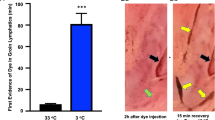Abstract
AN investigation has been made of the pharmacological properties of Cl. botulinum (type A) toxin. Rabbits injected intravenously with the toxin developed severe œdema with focal hæmorrhages in the lungs. These lung lesions were also found when ‘local' botulism was produced in a number of tissues, but with larger doses of toxin. It was therefore possible to achieve a local concentration of toxin sufficiently high to paralyse certain nerve-endings without killing the animals prematurely by the injury to the lungs.
This is a preview of subscription content, access via your institution
Access options
Subscribe to this journal
Receive 51 print issues and online access
$199.00 per year
only $3.90 per issue
Buy this article
- Purchase on Springer Link
- Instant access to full article PDF
Prices may be subject to local taxes which are calculated during checkout
Similar content being viewed by others
References
Edmunds, C. W., and Long, P. H., J. Amer. Med. Assoc, 81, 542 (1923).
Kegeles, G. J., J. Amer. Chem. Soc, 68, 1670 (1946).
Author information
Authors and Affiliations
Rights and permissions
About this article
Cite this article
AMBACHE, N. Peripheral Action of Botulinum Toxin. Nature 161, 482–483 (1948). https://doi.org/10.1038/161482b0
Issue Date:
DOI: https://doi.org/10.1038/161482b0
Comments
By submitting a comment you agree to abide by our Terms and Community Guidelines. If you find something abusive or that does not comply with our terms or guidelines please flag it as inappropriate.



